Abstract
Reclaimed asphalt pavement (RAP) has received wide application in asphalt pavement construction and maintenance and it has shown cost-effectiveness over virgin hot mix asphalt (HMA). HMA with a high content of reclaimed asphalt (RA) (e.g., 40%) is sometimes used in practice, however, it may have significant adverse effects on the life cycle performance and related costs. In particular, challenges may arise as the life cycle performance of RAP is also affected by local climatic conditions. Thus, it is important to investigate whether it is still economic to use RAP under future local climate, with consideration of life cycle performance. A case study was conducted for various road structures on Interstate 95 (I-95) in New Hampshire (NH), USA for the investigation. The case study utilized dynamic modulus testing results for local virgin HMA and HMA with 40% RA (as major material alternatives) to predict life cycle performance of the selected pavement structures, considering downscaled future climates. Then, a life cycle cost analysis (LCCA) was considered to estimate and compare the life cycle cash flow of the investigated road structures. Responsive maintenance (overlay) and effectiveness were also considered in this study. It was found that using 40% RA in HMA can reduce agency costs by up to approximately 18% under the 2020–2040 predicted climate and NH should consider this practice under predicted future climate to reduce agency costs.
1. Introduction
Reclaimed asphalt (RA) is a byproduct of asphalt pavement rehabilitation and has been used as an alternative material in hot mix asphalt (HMA). Recycled asphalt pavement (RAP) containing RA has been found to have lower life cycle environmental and economic impacts compared to HMA pavements [1,2,3,4,5]. In practice, the use of RA is usually driven by economic/environmental benefits in the production and transportation of the materials [6]. From a life cycle cost analysis (LCCA) perspective, such benefits are only a part of the total economic/environmental impacts. The LCCA, in this study, refers to a structured methodology to quantify and compare the cash flow during the life cycle of a pavement from cradle to grave [7]. The cash flow may not only occur in the production and transportation phases of the pavement materials, but also in the construction, maintenance, use, and end of life recycling phases of pavements.
Lee et al. investigated the economic benefits of utilizing RA in pavement base and sub-base layers [8]. An LCCA was conducted, considering agency costs and user costs (including work zone delay costs and crash costs). The life cycle performance was represented by pavement roughness (IRI) and was further used to estimate pavement service lives. It was concluded that adopting RAP can reduce life cycle costs by approximately 20%, compared to HMA pavements. A comprehensive LCCA study was conducted by Santos et al., where the economic advantages/disadvantages of in-place recycled pavements and conventional asphalt pavements were compared [9]. The LCCA included material acquisition, production, construction, maintenance, rehabilitation, transportation, work zone costs, usage, and end-of-life recycling phases. Road roughness was accounted for in this study. It was concluded that using RAP could reduce both agency and user costs. Although roughness (IRI) was commonly considered in many LCCA studies, the advantages/disadvantages of utilizing RA also depend on rutting and cracking performance [10].
Therefore, a comprehensive life cycle performance evaluation is needed to analyze subsequent maintenance interventions and related life cycle cost components. For example, a mechanistic–empirical simulation of life cycle performance and LCCA of RAP and conventional pavements was performed by Coleri et al. [11]. This study considered multiple life cycle performance indicators, including rutting, roughness, and cracking. The LCCA accounted for costs associated with raw materials, equipment, labor, traffic management, and lane closure. It was concluded that pavements with higher RA contents lead to lower life cycle costs (also supported by [12]). In addition, it was recommended that dynamic modulus tests need to be performed, to improve the prediction of life cycle performance and, thus, accuracy of the LCCA. The life cycle performance is an important consideration in a RAP LCCA because it can impact the functionality, ride quality, and, most importantly, affects the agency costs (e.g., maintenance costs) and user costs (e.g., fuel efficiency) [13,14,15]. While there are inconsistencies in evaluating laboratory performance of RA, it is generally agreed that RA can improve the rutting resistance of pavements but the resistance to thermal cracking reduces because the RA can increase the brittleness of the mixtures [16,17,18,19].
In addition, conventional mix design and LCCA usually assume a stationary climate. As a climate-sensitive infrastructure, the life cycle performance and costs can be impacted when the climate pattern varies in the future [19,20,21]. Moreover, the importance of durability in different climatic regions can be different. For example, rutting may be not a critical issue for asphalt pavements in cold climates, but thermal cracking can be. While in hot climates, rutting can be critical but not thermal cracking. Hence, it is important to account for local climates and material responses when evaluating the life cycle performance and costs of pavements. Although known as a more economic alternative to virgin HMA, the durability and economic benefits of RAP may change under future climates. Therefore, it is important to analyze and compare life cycle costs of pavements with RA and those without RA under anticipated future climates, in order to consider when it is economic for road agencies to use RA in future pavement construction and rehabilitation.
2. Methodology
The aim of this study is to conduct an LCCA to compare the long-term economic impacts of pavements under future climate, with two types of alternative asphalt mixtures, including a virgin HMA and HMA with 40% RA. A case study was conducted for Interstate 95 (I-95) in New Hampshire (NH), USA. Firstly, dynamic modulus testing was conducted for the two types of alternative local asphalt mixtures. The testing could evaluate elastic responses of the mixtures under different temperature ranges. Using the test results, pavement long-term performance was evaluated using Pavement ME, which is a state-of-the-art tool that can account for traffic, pavement structure, material, and regional climate. The dynamic modulus testing results were used as one of the key temperature-related material inputs for Pavement ME, in order to capture the mechanical responses of asphalt materials to temperature variations and to achieve greater accuracy in predicting pavement performance under the anticipated future climate [22]. In this study, the Coupled Model Inter-comparison Project Phase 5 (CMIP5) downscaled future climate data were applied to represent the future temperature and precipitation patterns for the investigated region and as another key input for long-term performance prediction. The downscaled future climate is believed to better describe extreme climate conditions at a local scale (12 × 12 km) and has been applied in various studies to predict pavement performance under future climates [22]. In Pavement ME, the future climate is translated into pavement temperature and moisture profiles by the enhanced integrated climate model (EICM) to predict pavement performance with climate variability [23]. This study also modeled a trigger-based responsive maintenance decision-making system (considering cracking, roughness, and rutting) and the subsequent maintenance effectiveness. The responsive maintenance decision-making is commonly adopted by various road agencies for maintenance scheduling. Finally, an LCCA was applied to compare the cash flow of different pavement structures in I-95 with the alternative asphalt materials (virgin HMA or HMA with 40% RA) in net present values (NPV), in all life cycle phases (including production, transportation, construction, maintenance, use, and salvage phases). The cash flows of pavements with alternative asphalt materials were compared in each phase. The details of the LCCA method are presented later in Section 2.4.
2.1. Case Study
The I-95 is one of the busiest interstate highways on the East coast of the USA. The length of the I-95 within NH is approximately 22 km. There are four lanes in each direction and the lane width is 12 feet (3.7 m). The highway was chosen for the case study because (a) state transportation agencies in the US, including NH Department of Transportation (DOT) are exploring the allowable amount of RA in asphalt mixtures; (b) data including traffic, pavement, climate, and dynamic modulus testing of paving materials are available; and (c) the Northeast region (including NH) has the greatest temperature warming trend observed in past decades in the United States [24]. Figure 1 shows the geographic location of the I-95 in NH. The annual average daily traffic (AADT) for the I-95 is estimated to be 88,000, with 10% heavy vehicles, by NH DOT [25]. The traffic growth rate is assumed to be 0% because, while adding the traffic growth rate may increase pavement deterioration and thus the related life cycle costs (LCC) components, no traffic growth estimate is available.
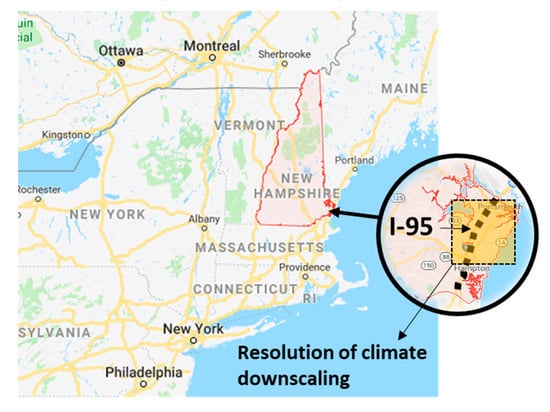
Figure 1.
Location of the case study (I-95 see the dotted bold line).
Some typical section profiles on the I-95 were identified and determined from the NH DOT’s project viewer [26,27]. In general, there are four types of structures, including a standard structure (SS), a medium strength structure (MS), a deep strength structure (DS), and a full depth structure (FD). Structure thickness information is provided in Table 1. For all the pavement structures, the asphalt concrete is estimated to consist of 81% aggregates, 13% bitumen, and 6.5% air voids by volume. Granular base is made of gravel. Sub-base is made of gravel (80%) and sand (20%) (AASHTO A-1-b). The subgrade is clay soil (AASHTO A-7-6) [22].

Table 1.
List of different pavement structures (1 inch = 2.54 cm).
2.2. Future Climate Data
Climate downscaling is used to project localized climate from climate models at larger scales (e.g., from global or regional climate models). Typically, climate predictions at larger scales use the general circulation models (GCM). When extreme weather is of concern, the GCM is not able to account for location specific land-surface features that form different local “microclimates”. Therefore, climate projections are often downscaled for a particular region, and over various time frames, as a basis for assessing the impact of climate change on highways. Utilization of downscaled climate projections has been applied in previous pavement studies where site-specific climate conditions are of concern [20,28]. For example, Meagher et al. [29] used existing regional climate model simulations from the North American Regional Climate Change Assessment Project to investigate deterioration of flexible pavement over time, as a result of projected climate change. In addition, various studies reported high precision and reliability of using climate downscaling techniques in predicting local climate extremes [30,31].
This study adopted downscaled CMIP5 climate projections where data on future daily maximum and minimum temperature and daily precipitation of selected 12 km by 12 km regions were available, covering a majority of the I-95 in NH [32] (see the square with dotted edge in Figure 1). Various studies demonstrated that temperature is one of the most critical climatic factors in the performance of asphalt pavements. Other climatic factors can be either insignificant in pavement performance modeling (e.g., wind speed and cloud cover) or prediction is not readily available (e.g., groundwater), thus, only temperature is commonly considered [20,33,34]. Prediction of future precipitation is also available so, although it may be insignificant, the downscaled precipitation is also used as an input into the Pavement ME. The CMIP5 climate projection results are dependent on the selected GCM, as different GCMs are based on slightly different approaches and are more accurate for a specific region. In this study, the daily maximum/minimum temperature and precipitation were calculated from the average of the total 21 GCM in CMIP5 results [32].
The climatic inputs to EICM are hourly climatic data. Various assumptions are used to translate the downscaled daily climate data into hourly data: (a) Daily minimum temperatures occur at the sunrise and daily maximum temperatures occur at 14:00 [35]. Hourly temperatures follow the sinusoid curve fitted from the daily maximum and minimum temperatures. (b) The maximum daily precipitation occurs in a random hour of each rainy day and the precipitation in the rest of the hours equals zero. (c) Wind speed, cloud cover, and moisture level adopt default historical data in EICM (for years 2000–2006).
The future climate is predicted under the representative concentration pathways (RCP) 4.5, meaning a medium future warming trend (compared to high and low emission scenarios, RCP 8.5 and RCP 2.6, respectively). RCP 4.5 is used to account for the future climate that is more likely to occur, according to the GCM predictions. High/low emission scenarios may overestimate/underestimate future consumption of fossil fuels and, thus, changes in climate [36].
The downscaled temperature data (RCP 4.5) for the period 2020–2040 were compared with the historical hourly temperature measured between February 2000 and February 2006. The probability density functions of the future and historical climate data of the investigated region are shown in Figure 2. The data suggest an increase of approximately 2 °C in the average temperature (from 8.3 °C to 10.3 °C) over the 21-year period (2020–2040) compared to the 7-year period (2000–2006). It can be seen from Figure 2 that there will be a reduction in the extreme cold hours (<−10 °C) and an increase in extreme hot hours (between 22 and 31 °C). In the medium temperature range (0–20 °C), there will be more hours with temperature ranging between 2 and 5 °C and between 15 and 20 °C. Hours with temperature ranging between 5 and 15 °C will decrease. The average annual rainfall over the 21-year future climate is predicted to be 8.4 inches (213 mm) more in the investigated region, compared to the 7-year historical rainfall. The hours with rainfall between 0 and 10 inches (0 and 254 mm) will have the greatest increases.
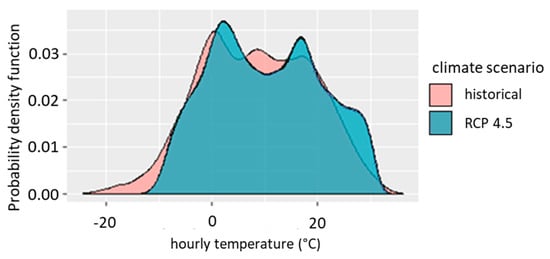
Figure 2.
Comparisons between historical and future temperature for I-95 New Hampshire (NH).
2.3. Life Cycle Performance
Pavement life cycle performance prediction is important for the LCCA, as it can be used to predict when maintenance cash flow will occur and how much it will be. In addition, user costs are usually associated with road roughness and, thus, more accurate prediction of roughness can lead to better estimation of user costs [13]. In this study, the Pavement ME was used to predict pavement performance, including roughness (in international roughness index, i.e., IRI), rutting, and cracking. Major inputs for the Pavement ME include traffic volume, truck percentage, pavement thickness, material properties (e.g., dynamic modulus), and hourly local climates.
To achieve better performance prediction accuracy, material properties for asphalt mixtures similar to those utilized in construction of the I-95 were utilized from previous research on assessment of high RA mixtures in Northeastern United States [37]. The results are shown in Table 2. Pavement performance was then predicted over its service life (20 years) for different structures with the two types of alternative asphalt materials under predicted climates. Other inputs including hourly/seasonal distribution of traffic distribution and granular material properties adopted Pavement ME default values.

Table 2.
Dynamic modulus test results on virgin asphalt and asphalt with 40% reclaimed asphalt (RA) [37].
Whenever any predicted performance indices reach maintenance triggers, it is considered that maintenance is performed. The maintenance triggers are 172 in/mi (2.7 m/km) for IRI, 0.75 in for rutting (19 mm), 25% for fatigue cracking, and 1000 ft/mi (190 m/km) for thermal cracking (AASHTO, 2009). To address non-load related cracking (e.g., thermal cracking), crack sealing and filling are assumed to be performed. When the thresholds for roughness, rutting, and fatigue cracking are reached, it is assumed that a 2 in (51 mm) overlay is constructed to address the distress. For maintenance effects, it is considered that crack sealing and filling and overlay will reset surface cracking and the overlay will have additional maintenance effects to address IRI and rutting.
This study adopted linear maintenance effects models for 2 in (51 mm) overlay, validated using maintenance data from the U.S. [38]. These linear models have been widely applied for maintenance effects modeling such as in the World Bank Highway Development and Management Model (HDM-4) [39,40,41]. Pavement ME predicted performance was then adjusted by the maintenance effects models, whenever maintenance was triggered.
2.4. Life Cycle Cost Analysis
The functional unit of analysis is the total costs (in million US dollars) per mile (1.6 km) of roadway over a 20-year pavement lifespan. The costs in the LCCA focus on the parts that are directly payable by road stakeholders i.e., agencies, construction companies, and users.
The life cycle costs cash flows are accounted for in various phases and the following costs are considered: (a) Production—the total costs of raw materials including asphalt mixtures, RA, and aggregates needed to build a unit length of the road (1 mile = 1.6 km). (b) Transportation—fuel consumption costs to transport asphalt mixtures, RA, gravel, and sand to the construction site; to transport maintenance materials to the maintenance site; and to transport the end of life materials to a recycling plant. (c) Construction—initial construction machinery costs including roller and paver for material placement and compaction, respectively. (d) Maintenance—the total costs to produce the overlay material (asphalt mixtures) and to construct overlay using roller and paver. (e) Use—user fuel consumptions. (f) Salvage (i.e., end of life recycling values)—the residual monetary value of the road for recycling (considered to be 40% (i.e., the recycling rate) of the costs of the virgin HMA, or equivalent to the allowable first-generation RA percentage, that could be saved in producing a new pavement with 40% RA). The total life cycle costs sum the cash flow from all phases and are converted to the NPV using Equation (1):
where,
- = net present value,
- = the cash flow of phase n in year t (i includes Phase a–f as described above),
- = discount rate (2%),
- = year.
An inventory of unit costs used to calculate the life cycle cost components is shown in Table 3.

Table 3.
Inventory of unit costs and other information [9,42,43].
The costs from the use phase adopt calibrated HDM-4 models [13]. The models can estimate fuel consumptions of five different types of vehicles (medium car, van, SUV, light truck, and articulated truck), based on the vehicle operating speed and road roughness. The 10% heavy vehicles on I-95 are assumed to consist of 60% light truck and 40% articulated truck, equivalent to 6% and 4% in AADT (see Table 3). The IRI of the highway changes with vehicle loading, climate loading, and is impacted by maintenance effects. It is assumed that all vehicles are operating at the design speed of the highway of 60 mph (96 km/h). The vehicle fuel consumption (at the operating speed on pavements with certain IRI levels) can be estimated using linear interpolation of the HDM-4 models.
3. Results and Discussion
In Section 3.1, the results of an exemplar structure (SS, see Table 1) are described and discussed, which also serves the purpose of demonstrating the research methodology. In Section 3.2, summarized results of all different structures in Table 1 are described.
3.1. Results for the Standard Strength Structure
The predicted life cycle performance under future climates is shown in Figure 3a–d. The pavement with virgin HMA first reaches the maintenance threshold for rutting; this is in the sixth year and an overlay is triggered (see Figure 3b). The maintenance effects reduce rutting and IRI, and reset fatigue and thermal cracking (see Figure 3a,c,d). Then, the overlay is triggered again in the 15th year, once more due to rutting. For HMA with 40% RA, thermal cracking first reaches the threshold and local crack sealing and filling is triggered in the third year (see Figure 3d). The intervention resets cracking but does not have effects on rutting, IRI, or fatigue cracking. Then, an overlay is triggered in the eighth year due to rutting and the maintenance reduces rutting and IRI, and resets fatigue and thermal cracking.
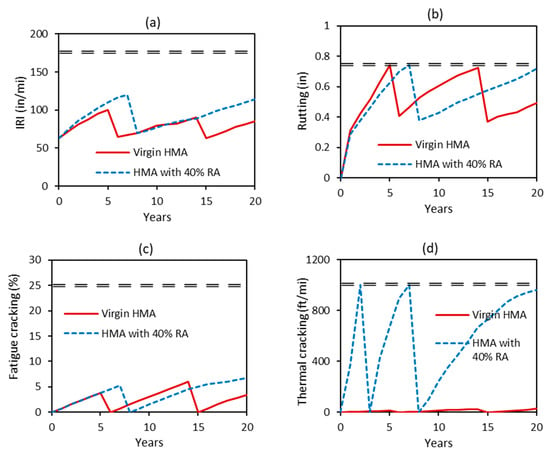
Figure 3.
Life cycle performance (the double-dashed lines indicate respective maintenance triggers; 50 in/mi = 0.79 m/km, 0.2 in = 5 mm, 400 ft/mi = 76 m/km). (a). IRI curve (b). rutting curve (c). fatigue cracking curve (d). thermal cracking curve.
The reason for the changes in performance are because the addition of the 40% RA increases the asphalt stiffness (dynamic modulus), which the rutting model estimates as an improvement, but it also accelerates the development of thermal cracks. In this case, the IRI and fatigue cracking were found not to trigger maintenance because they did not reach the trigger values for needing maintenance.
The calculated life cycle cash flows in NPV are shown in Figure 4. While other cash flows are similar, the cash flow in the maintenance phase is changed significantly, due to different durability and maintenance intervention for the two alternative asphalt materials. The total life cycle costs of HMA pavement with 40% RA, is about 2% less than the pavement with virgin HMA. When the use phase is excluded, the pavement with 40% RA costs 18.3% less than the pavement with virgin HMA. The total life cycle costs do not differ much, because the user fuel consumption is dominating, which is similar between the two alternatives. As seen from Figure 5, approximately 90% of life cycle costs are from road user fuel consumption (i.e., the use phase).
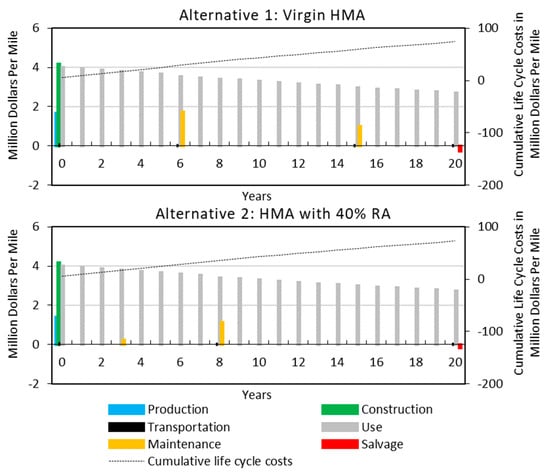
Figure 4.
Life cycle cost for hot mix asphalt (HMA) pavements and pavements with 40% RA (1 mile = 1.61 km).
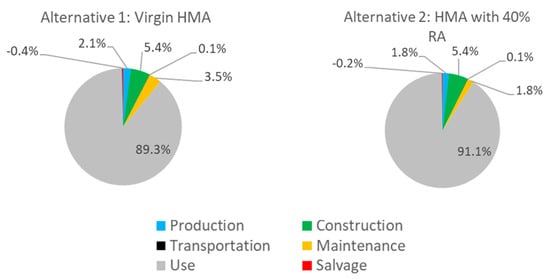
Figure 5.
Proportion of costs in different life cycle cost analysis (LCCA) phases.
The agency costs (including costs in the production, construction, transportation, maintenance, and salvage phases) only account for approximately 10% of the total life cycle costs. The production, construction, and maintenance phases are the major components of the agency costs and their proportions are approximately 5:2:3 for both alternatives. Comparisons were also made to show the relative differences in costs in different LCCA phases after normalizing the results (see Figure 6). It is shown that HMA with 40% RA results in much lower costs for maintenance, production, and transportation phases. This suggests that use of 40% RA reduces agency costs (nearly 20% less) over the pavements’ life cycle.

Figure 6.
Comparison of costs in different LCCA phases.
Although using 40% RA shows accelerated cracking, the cost of crack sealing and filling is much lower than applying an overlay (approximately 80% less). It can improve rutting performance and, thus, reduces the overlay frequency and the consequent maintenance and transportation costs significantly. Also, use of 40% RA saves costs in the production phase as the RA is less expensive than virgin HMA. It may further reduce costs in production and transportation of asphalt materials and, thus, reduces life cycle costs, if RA is recycled on-site (compared to recycled from the mixing plant, as considered in this case). The salvage value of the asphalt layers is less for HMA with RA. This is probably the only economic disadvantage of using RAP, however, the proportion of salvage value is insignificant in the agency or life cycle costs (see Figure 4 and Figure 5). The salvage value for HMA with RA is less because it already has 40% RA in the asphalt material before recycling and, thus, the value of being recycled is less.
Although user costs (e.g., longer detour, queueing, or accidents at maintenance work zones) can increase due to increases in maintenance frequency or intensity, these costs were not considered in this study. Future studies should explore the work zone user costs.
3.2. Results of All Structures
The analysis described above was performed for all the rest of the structures presented in Table 1, with virgin HMA and HMA with 40% RA as the asphalt courses. Figure 7 shows the terminal values of different performance indices, which were obtained from the Pavement ME predicted performance indices under future climates at the end of the design life (20 years) without maintenance. In general, the thresholds for IRI and fatigue cracking were not found to be exceeded. Maintenance is triggered due to problems related to rutting and thermal cracking.
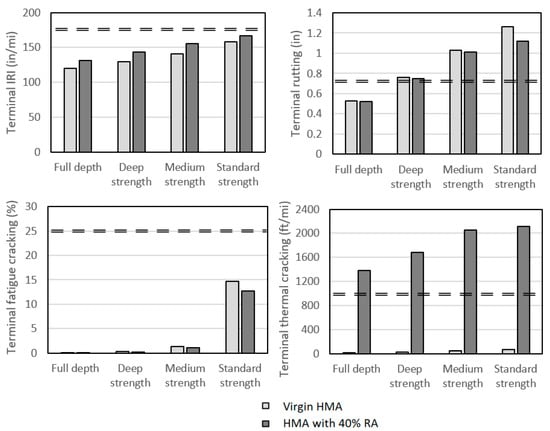
Figure 7.
Terminal values of performance indices (the double-dashed lines indicate respective maintenance triggers, 50 in/mi = 0.79 m/km; 0.2 in = 5 mm; 400 ft/mi = 76 m/km).
It can be seen from Figure 7 that the rutting resistance of HMA is found to increase with the addition of RA. However, adding 40% RA significantly reduces its capacity to resist thermal cracking. For RA, the aging process in its previous life cycle increased its stiffness. As can be seen from Table 1, the stiffness of the HMA with 40% RA is greater than the virgin HMA, at a specified temperature and loading frequency. The increases in stiffness allow HMA with 40% RA to spread traffic loading better and thus can alleviate the development of rutting. However, the aging process has increased the brittleness of the asphalt material and led to much worse performance in thermal cracking. IRI is found to increase with adding 40% RA but the HMA gained resistance to fatigue cracking.
Maintenance scheduling is performed based on the predicted performance indicators over the pavements’ service lives and their respective maintenance triggers. The results are presented in Figure 8. The matrix shows that adding 40% RA required additional treatment for cracking for all structures but reduced the application frequency of the overlay for the SS structure. As rutting performance is improved, it has the effect of delaying application of overlays for MS and DS structures.

Figure 8.
Maintenance scheduling matrix for all structures.
A summary of the NPV calculations is presented in Figure 9. Figure 9a shows the comparisons of agency costs, which is a sum of the NPV from production, construction, transportation, maintenance, and salvage phases. Figure 9b presents the NPV comparisons of user costs for different pavement structures with or without 40% RA.
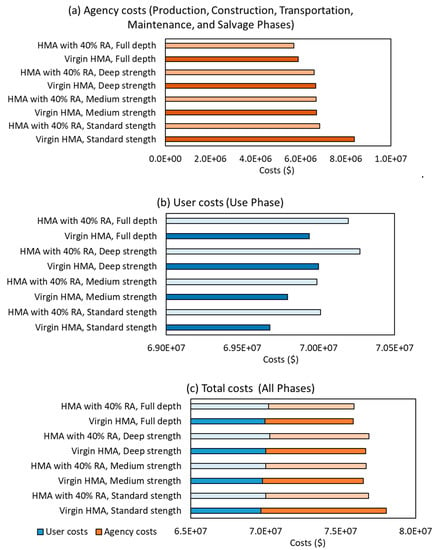
Figure 9.
Life cycle cost summary: (a) agency costs, (b) user costs, (c) total costs (note: The columns of the user costs and total costs do not start from zero).
It can be seen from Figure 9a that the agency costs of HMA with 40% RA are less than virgin HMA for all structures, due to its material saving in the production phase. The reduction ranges between 0.2%–18.3%. Although it requires more treatment for thermal cracking, the incurred additional maintenance costs were less than the production cost savings. In particular, the agency cost reduction is significant for the SS structure (18.3%). This is because the application of RA reduced the frequency of the overlay treatment for the SS structure (see Figure 8). In addition, the agency costs reduce as the structures become stronger (stronger (FD > DS > MS > SS) weaker). Although stronger structures cost more in the production phase, they can save considerable costs in the maintenance phase and their salvage values are greater.
On the contrary, user costs become greater for HMA with 40% RA (see Figure 9b). This is because pavements surfaced with 40% RA are rougher (see Figure 7) over their service cycles and this leads to greater fuel consumption. The roughness issue is not caused by rutting, as the addition of RA increased rutting resistance (see Figure 7). It may be caused by degraded thermal cracking performance. In addition, stronger structures may induce greater user costs. This is because less strong pavements require more frequent maintenance, which leads to higher average performance levels and, thus, fuel-saving. In other words, more investment from an agency (i.e., agency costs) can reduce user costs. While the proportion of the user costs is significant in the total NPV (approximately 90%), their differences are not significant enough to influence the ranking of the total costs (see Figure 9c). The mean value (µ) for life cycle user costs is approximately $70,000,000 with a standard deviation (σ) of $180,000.
Figure 9c shows that the life cycle costs for pavements made of HMA with 40% RA are more than the costs of pavements surfaced with virgin HMA, including the MS, DS, and FD structures. However, the difference seems insignificant. For the SS structure, on the contrary, the total costs become much less with 40% RA. In addition, the life cycle costs of a weaker structure are greater than those of a stronger structure. Again, the differences are not significant. This is because the user costs “boost” the total life cycle costs. In fact, the absolute values of the user costs are close to each other among different structures and their differences can be neglected (σ is only 0.25% of µ). This is particularly true when considering that there are inherent uncertainties in the fuel consumption models and imprecision/variabilities in the results might be greater than the existing uncertainty in the results. Therefore, user costs of different structures can be considered as approximately equivalent when work zone delay costs are not included.
Thus, the focus can be placed on agency costs. It can be inferred that agencies will benefit from reduced costs by applying 40% RA in new and rehabilitated pavements in the next two decades. In particular, thin pavements (e.g., the SS structure) will benefit more when 40% RA is utilized. Figure 10 shows that the most significantly changed life cycle components between pavements with virgin HMA and with 40% RA are from the production, maintenance, and salvage phases. In the production phase, NPV can reduce 15%–25% when 40% RA is used. HMA with 40% RA has less salvage value when it is recycled again. However, the performance of the second generation RAP needs further investigation, either in laboratories or on site.
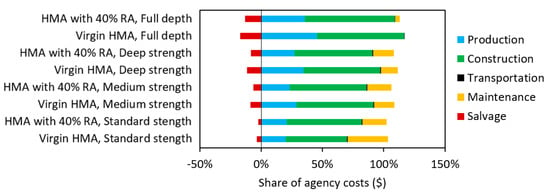
Figure 10.
Share of agency costs.
Application of 40% RA may increase or decrease the maintenance costs, depending on different cases. In general, pavements with 40% RA will likely need more treatment to address thermal cracking issues but can provide better resistance against rutting. If adding 40% RA can reduce the frequency of overlay treatments, it can save significant maintenance NPV (e.g., 50% reduction for the SS structure). However, adding 40% RA caused additional treatment costs to address thermal cracking. In practice, thermal cracking usually initiates from the top of pavements, due to repeated changes in air temperature. Relatively low-cost treatments such as crack sealing and filling can be applied to pavement surfaces and address cracking issues. However, an overlay treatment usually costs much more in terms of material, machinery, and labor. An agency may need to balance the tradeoffs between the two maintenance costs by selecting a proper RA percentage.
4. Conclusions and Recommendations
This study investigated the life cycle costs of two asphalt concrete alternatives on four typical structures of the 22 km Interstate 95 highway in New Hampshire. The material alternatives include a) virgin HMA and b) HMA with 40% RA. Dynamic modulus test results for the alternative materials were used as a key asphalt material input into Pavement ME to model the long-term performance under a downscaled future climate. Based on the performance prediction, a responsive maintenance decision-making system and maintenance effects were modeled. Then, a life cycle cost analysis was conducted, considering net present values from the production, construction, transportation, maintenance, use, and salvage phases. The following conclusions can be drawn:
- For road agencies, using 40% RA can remain a more economic practice than using 100% virgin HMA for I-95 in New Hampshire under 2020–2040 climates.
- User costs, not including work zone delay costs, in terms of fuel consumption may increase or decrease on pavements with 40% RA compared with pavements with virgin hot mix asphalt, however, the increase/decrease was found to be insignificant.
- Agency costs were found to reduce by up to 18.3% over the pavements’ service lives when 40% RA is used, compared to virgin hot mix asphalt. The reduction was found to be greater for thinner pavements (e.g., the standard structure in Table 1).
- In the production phase, net present values were found to reduce approximately 15%–25% when 40% RA is used. HMA with 40% RA is predicted to have improved resistance to rutting but cracking will be expected to be worse.
These conclusions were drawn based on predicted climate conditions (2020–2040), when the average temperature will be 2 °C higher than the baseline (2000s). This study recommends evaluating mix designs with different RA percentages to minimize costs in the maintenance phase in different climate regions. Work zone delay costs should be included in future studies. In addition, this study assumed constant traffic volume and constant fuel efficiency over time. Traffic prediction models and fuel consumption models may need to be revised when they are available, to provide a more accurate prediction of costs in the use phase to account for increases in traffic demands, improved fuel efficiency, or alternative fuels of future vehicles [14].
Author Contributions
Conceptualization, Y.Q., E.D., and T.P.; methodology, Y.Q.; software, Y.Q. and O.V.; validation, L.M., G.N., and Z.Y.; analysis, Y.Q. and Y.Z.; writing, Y.Q, Y.Z.; revising, T.P., E.D., and L.M.
Funding
This research was primarily funded by the University of New Hampshire Center for Infrastructure Resilience to Climate (UCIRC). In addition, this research was partly supported by Hebei Education Department (grant number: QN2019234), the Natural Science Foundation of China (grant number: 11972237), and the Key Project of Scientific Research Foundation for the Returned Overseas Scholars of Heber province (C20190513). The authors gratefully acknowledge their financial support.
Conflicts of Interest
The authors declare no conflict of interest.
References
- Giani, M.I.; Dotelli, G.; Brandini, N.; Zampori, L. Comparative life cycle assessment of asphalt pavements using reclaimed asphalt, warm mix technology and cold in-place recycling. Resour. Conserv. Recycl. 2015, 104, 224–238. [Google Scholar] [CrossRef]
- Aurangzeb, Q.; Al-Qadi, I.L.; Ozer, H.; Yang, R. Hybrid life cycle assessment for asphalt mixtures with high RAP content. Resour. Conserv. Recycl. 2014, 83, 77–86. [Google Scholar] [CrossRef]
- Yang, R.; Ozer, H.; Kang, S.; Al-Qadi, I.L. Environmental Impacts of Producing Asphalt Mixtures with Varying Degrees of Recycled Asphalt Materials. In Proceedings of the International Symposium on Pavement LCA, Davis, CA, USA, 14–16 October 2014. [Google Scholar]
- Santos, J.; Bryce, J.; Flinsch, G.; Ferreira, A.; Diefenderfer, B. A life cycle assessment of in-place recycling and conventional pavement construction and maintenance practices. Struct. Infrastruct. Eng. 2015, 11, 1199–1217. [Google Scholar] [CrossRef]
- Del Ponte, K.; Natarajan, B.M.; Ahlman, A.P.; Baker, A.; Elliot, E.; Edil, T.B. Life-Cycle Benefits of Recycled Material in Highway Construction. Transp. Res. Rec. 2017, 2628, 1–11. [Google Scholar] [CrossRef]
- Copeland, A. Reclaimed Asphalt Pavement in Asphalt Mixtures: State of the Practice; Report FHWA-HRT-11-021; FHWA: Washington, DC, USA, 2011.
- Federal Highway Administration (FHWA). Life-Cycle Cost Analysis in Pavement Design; FHWA-SA-98-079; Federal Highway Administration: Washington, DC, USA, 1998.
- Lee, J.C.; Edil, T.B.; Tinjum, J.M.; Benson, C.H. Quantitative Assessment of Environmental and Economic Benefits of Recycled Materials in Highway Construction. Transp. Res. Rec. 2010, 2158, 138–142. [Google Scholar] [CrossRef]
- Santos, J.; Bryce, J.; Flintsch, G.; Ferreira, A. A comprehensive life cycle costs analysis of in-place recycling and conventional pavement construction and maintenance practices. Int. J. Pavement Eng. 2015, 18, 727–743. [Google Scholar] [CrossRef]
- Wang, Y. The effects of using reclaimed asphalt pavements (RAP) on the long-term performance of asphalt concrete overlays. Constr. Build. Mater. 2016, 120, 335–348. [Google Scholar] [CrossRef]
- Coleri, E.; Zhang, Y.; Wruck, B.M. Mechanistic-Empirical Simulations and Life-Cycle Cost Analysis to Determine the Cost and Performance Effectiveness of Asphalt Mixtures Containing Recycled Materials. Transp. Res. Rec. 2018, 2672, 143–154. [Google Scholar] [CrossRef]
- Aurangzeb, Q.; Al-Qadi, I. Asphalt Pavements with High Reclaimed Asphalt Pavement Content: Economic and Environmental Perspectives. Transp. Res. Rec. 2014, 2456, 161–169. [Google Scholar] [CrossRef]
- Chatti, K.; Zabaar, I. Estimating the Effects of Pavement Condition on Vehicle Operating Costs; NCHRP Report 720; NCHRP: Washington, DC, USA, 2012. [Google Scholar]
- Trupia, L.; Parry, T.; Neves, L.; Lo Presti, D. Rolling resistance contribution to a road pavement life cycle carbon footprint analysis. Int. J. Life Cycle Assess. 2017, 22, 972. [Google Scholar] [CrossRef]
- Wang, T.; Lee, I.-S.; Kendall, A.; Harvey, J.; Lee, E.-B.; Kim, C. Life cycle energy consumption and GHG emission from pavement rehabilitation with different rolling resistance. J. Clean. Prod. 2012, 33, 86–96. [Google Scholar] [CrossRef]
- Al-Qadi, I.L.; Elseifi, M.; Carpenter, S.H. Reclaimed Asphalt Pavement—A Literature Review; Report: FHWA-ICT-07-001; FHWA: Washington, DC, USA, 2007.
- Shu, X.; Huang, B.; Vukosavljevic, D. Laboratory evaluation of fatigue characteristics of recycled asphalt mixture. Constr. Build. Mater. 2008, 22, 1323–1330. [Google Scholar] [CrossRef]
- Silva, H.M.R.D.; Oliveira, J.R.M.; Jesus, C.M.G. Are totally recycled hot mix asphalts a sustainable alternative for road paving? Resour. Conserv. Recycl. 2012, 60, 38–48. [Google Scholar] [CrossRef]
- Qiao, Y.; Dawson, A.R.; Parry, T.; Flintsch, G.W. Evaluating the effects of climate change on road maintenance intervention strategies and Life-Cycle Costs. Transp. Res. D Transp. Environ. 2015, 41, 492–503. [Google Scholar] [CrossRef]
- Underwood, B.S.; Guido, Z.; Gudipudi, P.; Feinberg, Y. Increased costs to US pavement infrastructure from future temperature rise. Nat. Clim. Chang. 2017, 7, 704–707. [Google Scholar] [CrossRef]
- Chinowsky, P.; Scheikert, A.E.; Strzepek, N.L.; Strzepek, K. Road Infrastructure and Climate Change in Vietnam. Sustainability 2015, 7, 5452–5470. [Google Scholar] [CrossRef]
- American Association of State Highway and Transportation Officials (AASHTO). Mechanistic-Empirical Pavement Design Guide (MEPDG), version 1.1; National Cooperative Highway Research Program: Washington, DC, USA, 2009. [Google Scholar]
- Zapata, C.E.; Andrei, D.; Witczak, M.W.; Houston, W.N. Incorporation of Environmental Effects in Pavement Design. Road Mater. Pavement Des. 2007, 8, 667–693. [Google Scholar] [CrossRef]
- Melillo, J.M.; Richmond, T.; Yohe, G.W. Climate Change Impacts in the United States: The Third National Climate Assessment; U.S. Global Change Research Program: Washington, DC, USA, 2014. [Google Scholar]
- State of New Hampshire Department of Transportation Bureau of Traffic (NHDOT). I-95 Traffic Volume Report; State of New Hampshire Department of Transportation Bureau of Traffic: Concord, NH, USA, 2016. [Google Scholar]
- Valle, O.; Qiao, Y.; Dave, E.; Mo, W. Life Cycle Assessment of Pavements under a Changing Climate. In Proceedings of the Pavement LCA Conference, Champaign, IL, USA, 12–13 April 2017; Taylor & Francis Group: London, UK, 2017. [Google Scholar]
- DeCarlo, C.; Mo, W.; Dave, E.V.; Locore, J. Sustainable Pavement Rehabilitation Strategy Using Consequential Life Cycle Assessment: An Example of Interstate 95. In Proceedings of the Tenth International Conference on the Bearing Capacity of Roads, Railways and Airfields (BCRRA 2017), Athens, Greece, 28–30 June 2017; Loizos, A., Al-Qadi, I., Scarpas, T., Eds.; CRC Press: Boca Raton, FL, USA, 2017. [Google Scholar]
- Stoner, A.; Daniel, J.; Jacobs, J.; Hayhoe, K.; Scott-Fleming, I. Quantifying the Impact of Climate Change on Flexible Pavement Performance and Lifetime in the United States. Transp. Res. Rec. 2019, 2673, 110–122. [Google Scholar] [CrossRef]
- Meagher, W.; Daniel, J.S.; Jacobs, J.; Linder, E. Method for Evaluating Implications of Climate Change for Design and Performance of Flexible Pavements. Transp. Res. Rec. 2012, 2305, 111–120. [Google Scholar] [CrossRef]
- Saymohamadi, S.; Zarafshani, K.; Tavakoli, M.; Mahdizadeh, H.; Amiri, F. Prediction of Climate Change Induced Temperature & Precipitation: The Case of Iran. Sustainability 2017, 9, 146. [Google Scholar] [CrossRef]
- Kristvik, E.; Johannessen, B.G.; Muthana, T.M. Temporal Downscaling of IDF Curves Applied to Future Performance of Local Stormwater Measures. Sustainability 2019, 11, 1231. [Google Scholar] [CrossRef]
- Brekke, L.; Thrasher, B.L.; Maurer, E.P.; Pruitt, T. Downscaled CMIP3 and CMIP5 Climate Projections. Release of Downscaled CMIP5 Climate Projections, Comparison with Preceding Information, and Summary of User Needs; United States Bureau of Reclamation: Washington, DC, USA, 2013. [Google Scholar]
- Qiao, Y.; Flintsch, G.; Dawson, A.; Parry, T. Examining Effects of Climatic Factors on Flexible Pavement Performance and Service Life. Transp. Res. Rec. 2013, 2349, 100–107. [Google Scholar] [CrossRef]
- Yang, X.; You, Z.; Hiller, J.; Watkins, D. Sensitivity of flexible pavement design to Michigan’s climatic inputs using Pavement ME design. Int. J. Pavement Eng. 2015, 18, 622–632. [Google Scholar] [CrossRef]
- Hoogenboom, G.; Huck, M.G. A dynamic Simulation of Root Growth, Water Uptake, and Biomass Partitioning in a Soil-Plant-Atmosphere Continuum: Update and Documentation; Agronomy and Soils Department Series 109; Alabama Agricultural Experiment Station: Auburn, AL, USA, 1986. [Google Scholar]
- Wang, J.; Feng, L.; Tang, X.; Bentley, Y.; Höök, M. The implications of fossil fuel supply constraints on climate change projections: A supply-side analysis. Futures 2017, 86, 58–72. [Google Scholar] [CrossRef]
- Daniel, J.S.; Bennert, T.; Kim, Y.R.; Mogawer, W.; Congalton, A.; Elwardany, M.; Mensching, D.; Saboury, M. TPF 5(230): Evaluation of Plant Produced RAP Mixtures in North-East; US DOT Transportation Pooled Fund Program: Washington, DC, USA, 2015. [Google Scholar]
- Qiao, Y.; Dawson, A.; Parry, T.; Flintsch, G.W. Immediate effects of some corrective maintenance interventions on flexible pavements. Int. J. Pavement Eng. 2018, 19, 502–508. [Google Scholar] [CrossRef]
- Kerali, H.G.R.; Odoki, J.B.; Standard, E.E. Overview of HDM-4; Highway Development and Management Series; International Study of Highway Development and Management: Birmingham, UK, 2006. [Google Scholar]
- Odoki, J.B.; Kerali, H.G.R.; Highway Development and Management. HDM-4, Technical Reference Manual; PIARC: Paris, France, 1999. [Google Scholar]
- Djarf, L. Road Deterioration and Maintenance Effects Models in Cold Climates; Swedish Road Research Institute: Stockholm, Sweden, 1995. [Google Scholar]
- Nathman, R.K. PALATE User Guide, Example Exercise, and Contextual Discussion. Master’s Thesis, University of Delaware, Newark, DE, USA, 2008. [Google Scholar]
- Goedkoop, M.; Oele, M.; Leijting, J.; Ponsioen, T.; Meijer, E. Introduction to LCA with SimaPro; Pré Consultants: San Francisco, CA, USA, 2016. [Google Scholar]
© 2019 by the authors. Licensee MDPI, Basel, Switzerland. This article is an open access article distributed under the terms and conditions of the Creative Commons Attribution (CC BY) license (http://creativecommons.org/licenses/by/4.0/).